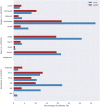On the analysis of mortality risk factors for hospitalized COVID-19 patients: A data-driven study using the major Brazilian database
- PMID: 33735272
- PMCID: PMC7971705
- DOI: 10.1371/journal.pone.0248580
On the analysis of mortality risk factors for hospitalized COVID-19 patients: A data-driven study using the major Brazilian database
Abstract
Background: Brazil became the epicenter of the COVID-19 epidemic in a brief period of a few months after the first officially registered case. The knowledge of the epidemiological/clinical profile and the risk factors of Brazilian COVID-19 patients can assist in the decision making of physicians in the implementation of early and most appropriate measures for poor prognosis patients. However, these reports are missing. Here we present a comprehensive study that addresses this demand.
Methods: This data-driven study was based on the Brazilian Ministry of Health Database (SIVEP-Gripe) regarding notified cases of hospitalized COVID-19 patients during the period from February 26th to August 10th, 2020. Demographic data, clinical symptoms, comorbidities and other additional information of patients were analyzed.
Results: The hospitalization rate was higher for male gender (56.56%) and for older age patients of both sexes. Overall, the lethality rate was quite high (41.28%) among hospitalized patients, especially those over 60 years of age. Most prevalent symptoms were cough, dyspnoea, fever, low oxygen saturation and respiratory distress. Cardiac disease, diabetes, obesity, kidney disease, neurological disease, and pneumopathy were the most prevalent comorbidities. A high prevalence of hospitalized COVID-19 patients with cardiac disease (65.7%) and diabetes (53.55%) and with a high lethality rate of around 50% was observed. The intensive care unit (ICU) admission rate was 39.37% and of these 62.4% died. 24.4% of patients required invasive mechanical ventilation (IMV), with high mortality among them (82.98%). The main mortality risk predictors were older age and IMV requirement. In addition, socioeconomic conditions have been shown to significantly influence the disease outcome, regardless of age and comorbidities.
Conclusion: Our study provides a comprehensive overview of the hospitalized Brazilian COVID-19 patients profile and the mortality risk factors. The analysis also evidenced that the disease outcome is influenced by multiple factors, as unequally affects different segments of population.
Conflict of interest statement
The authors have declared that no competing interests exist.
Figures







References
-
- WHO. World Health Organization. WHO announces COVID-19 outbreak a pandemic; 2020. Available from: http://www.euro.who.int/en/health-topics/health-emergencies/coronavirus-....
-
- WHO. World Health Organization. Coronavirus Disease (COVID-19) Dashboard; 2020. Available from: https://covid19.who.int.
Publication types
MeSH terms
LinkOut - more resources
Full Text Sources
Other Literature Sources
Medical

